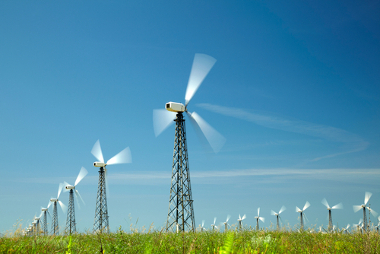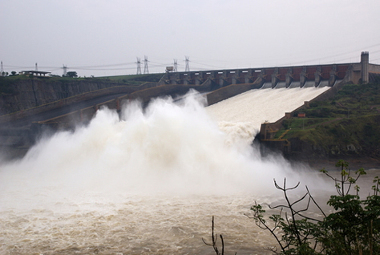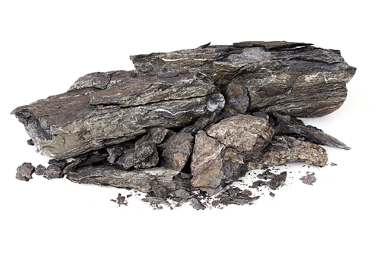Renewable energy sources are those forms of energy production in which their sources are capable of remain available for a long term, relying on resources that regenerate or remain active permanently. In other words, renewable energy sources are those that have non-exhaustible resources.
There are several types of renewable energy sources, including solar, wind, water, biomass, geothermal, wave and tidal. See a brief summary of each of these non-exhaustible energies:
Solar energy
It consists of taking advantage of solar radiation emitted on the Earth. It is, therefore, an energy source that, in addition to being inexhaustible, is highly potent, as a large amount of radiation is emitted on the planet every day. Its main question, however, is not its availability in nature, but the ways to use it for the generation of electricity.

solar energy collection station
There are two ways of using solar energy, photovoltaic, in which photovoltaic panels convert solar radiation into electrical energy, and thermal, which heats water and the environment, being used in homes or also in thermoelectric plants through the conversion of water into steam, which is responsible for moving the turbines that drive the generators.
Mind Map: Alternative Energy Sources

*To download the mind map in PDF, Click here!
wind energy
It uses the force promoted by the winds to produce energy. Its importance has been growing nowadays because, like solar energy, it does not emit pollutants into the atmosphere. Wind power plants use large pinwheels installed in areas where the movement of air masses is intense and constant for most of the year. The winds turn the propellers, which in turn move the turbines, driving the generators.

Wind power production station
Although this energy source is quite efficient and praised, it has some limitations, such as the non-permanent character. totally constant winds during the year, with interruptions, and the difficulty of energy storage produced.
Hydro or hydropower
In turn, the hydroelectric power it uses the movement of water from rivers to produce electricity. In countries like Brazil, Russia, China and the United States, it is widely used by plants that transform hydraulic and kinetic energy into electricity.

Itaipu hydroelectric plant, the second largest in the world
As it is necessary to establish a flood area in the environment where a hydroelectric plant is installed, its construction is recommended in areas of plateau, where the terrain is steeper and more uneven, as plain rivers need more space for water damming, which generates more impacts environmental issues.
Do not stop now... There's more after the advertising ;)
On the one hand, hydroelectric power plants bring several environmental damages, not only due to the flooding of natural areas and the diversion of river beds, as well as the carbon dioxide emitted by the decomposition of organic matter that forms in the flooded. On the other hand, this is considered an efficient form of electricity generation, in addition to being less polluting, for example, than thermoelectric plants powered by fossil fuels.
biomass energy
THE biomass corresponds to any and all non-fossil organic matter. Thus, this material can be used for burning and producing energy, which is why it is considered a renewable source. Its importance lies in the use of materials that, in theory, would be disposable, such as agricultural waste (mainly sugarcane bagasse), and also in the possibility of cultivation.

Biomass is used as a source of electricity and also as a biofuel
There are three types of biomass used as an energy source: solids, liquids and gases.
Solid fuels: we can mention wood, charcoal and organic vegetable and animal waste.
Liquid fuels: ethanol, biodiesel and any other liquid obtained by the transformation of organic material by chemical or biological processes.
Gaseous fuels: those that are obtained by industrial or even natural transformation of organic waste, such as biogas and methane gas collected in landfill areas.
Geothermal energy
THE geothermal energy corresponds to the Earth's internal heat. In cases where this heat manifests itself in areas close to the surface, the high underground temperatures are used to produce electricity.

Geothermal Power Plant
Basically, geothermal power plants inject water underground through pipelines specifically designed for this purpose. This water evaporates and is conducted through the same tubes to the turbines, which move and activate the electricity generator. To reuse water, the steam is again transported to areas where it returns to its liquid form, restarting the process.
The main problem of geothermal energy is its environmental impact through possible pollutant emissions, in addition to chemical soil pollution in some cases. Added to this are the high implementation and maintenance costs.
Wave and tidal energy
It is possible to use sea water for the production of electricity both by taking advantage of the waves and by using the tidal energy. In the first case, the movement of waves is used in environments where they are more intense for energy generation. In the second case, the operation resembles that of a hydroelectric power plant, as a dam is created that captures water from the tides during their floods, and this water is released when the tides decrease. During this release, the water turns the turbines that activate the generators.
By Me. Rodolfo Alves Pena
*Mental Map by Rafaela Sousa
Graduated in Geography


